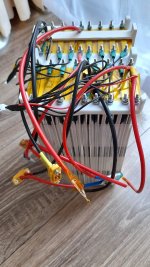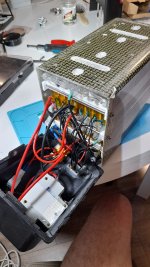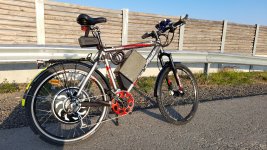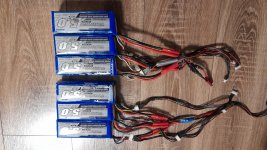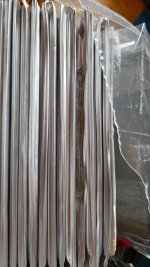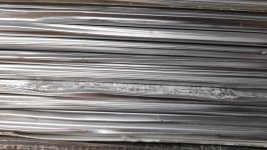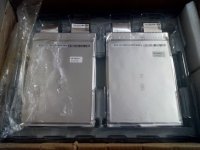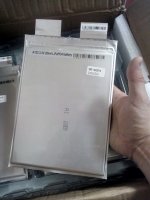Hi, I would like to ask you. I have A123 LiFePO4 pouch cells 20Ah on my ebike. I bought them from Cina, from Lithium Batteries,Motorcycle Batteries,Solar Batteries,KOK Power Limited. They got me very good price, two years before. When I got them, I was amazed. All of them had exactly 3,300 V. I have two packs of 8 of them in one, because I charge them with my M8S ToolkitRC charger, then I connect them with switch to 16 in series. They have may be only 100-150 full cycles but, I dont know why, the first and last cell of both packs is charged and discharged as first one. I have to charge still in balance mode, because then is voltage on every cell different more than 0,2-0,3 V, what is unacceptable. I do not have any BMS on it, because I had idea, that I will not need it, when I will charge them in balance mode. I used before Lipol 5S Turnigy cells I charged them without balance mode, only sometimes, may be one time per two months check them and difference was not more then 0,03 V between cells. So are these LiFePO4 pouch cell so poor quality, or is there any other problem, why first and last cell from whole pack is still as first charged and first discharged? Thank you very much.
You are using an out of date browser. It may not display this or other websites correctly.
You should upgrade or use an alternative browser.
You should upgrade or use an alternative browser.
A123 pouch cells LIFePO4 balancing issue
- Thread starter Bublifuk
- Start date
Is the pack just built "loose" (cells just taped together) like seen in the images, or is there a compression plate on each end of each stack of cells that clamps the stack down?
If there isn't sufficient, even compression across all the cells, end cells may degrade faster than core cells because they are able to develop gas internally between layers, which decreases the active surface area of the cell, increasing it's internal resistance (more voltage sag under load) and decreasing it's capacity (fills and empties faster than others).
In general, pouch cells (really anything other than cylindrical cells) require compression, the spec sheet for the cell should call this out (but they don't all); the PSI spec for the A123 cells is around here somewhere in an old discussion, posted by WB9K (who worked for A123).
If you look thru my posts for the last two or three months for "compression" or "pouch" you should find some images of packs built with compression.
(RC Lipo often suffers from this problem, too, for this reason among others).
Not every cell or pack will experience a problem...but they can.
Also...some time ago there were a bunch of cells scrapped by A123, Fiskar / etc for various defects, these were sent to China for recycling, but were apparently diverted into resale instead, some as individual cells for sale, and some built up as packs. Some of these cells were scrapped out of OEM packs and so have short tabs, some were from internal QC failures and hadn't been built into anything yet, so they have full length tabs. There's threads about these things if you're interested, from years back, with some hard data and a fair bit of speculation.
If there isn't sufficient, even compression across all the cells, end cells may degrade faster than core cells because they are able to develop gas internally between layers, which decreases the active surface area of the cell, increasing it's internal resistance (more voltage sag under load) and decreasing it's capacity (fills and empties faster than others).
In general, pouch cells (really anything other than cylindrical cells) require compression, the spec sheet for the cell should call this out (but they don't all); the PSI spec for the A123 cells is around here somewhere in an old discussion, posted by WB9K (who worked for A123).
If you look thru my posts for the last two or three months for "compression" or "pouch" you should find some images of packs built with compression.
(RC Lipo often suffers from this problem, too, for this reason among others).
Not every cell or pack will experience a problem...but they can.
Also...some time ago there were a bunch of cells scrapped by A123, Fiskar / etc for various defects, these were sent to China for recycling, but were apparently diverted into resale instead, some as individual cells for sale, and some built up as packs. Some of these cells were scrapped out of OEM packs and so have short tabs, some were from internal QC failures and hadn't been built into anything yet, so they have full length tabs. There's threads about these things if you're interested, from years back, with some hard data and a fair bit of speculation.
Last edited:
Thank you very much for your reply. This is interesting idea, but. As you can see from pictures, all 16 cells are together, so last one and first one cell from first and second pack is in the middle of whole pack. If you know what I mean. More over, whole pack is really tight inserted in kevlar carbon case. There is no place, where the cells could to puff up. I had opened this case couple months before, because I noticed, that one cell is behaving strangely. Unfortunately the cell was dead. The cell had no voltage and had some leakage, fortunately the liquid did not get from shell of the cell. As you wrote about internal resistance. All cells have plus minus the same internal resistance between 5 to 8 mili ohm. I little bit suspect my charger and I have to check the values, if they are correct. I'm a bit disappointed, because I tough, that I will have peace for many years with these lifepo4 cells :-(. I think that these cells were not rebranded, just have lower quality.
Attachments
Some thoughts:
If the cells didn't come from A123, there's a significant chance that they are genuine but not intended to be sold (were scrapped due to defects or damage), and should have been recycled but instead were resold. (as noted previously).
The kevlar/carbon case can still flex enough to allow the inter-layer gas bubble formation. With A123 cells you generally won't see puffing like you would with RC Lipo cells, for instance, unless they're really bad, but the microscopic bubbles that could form within an uncompressed cell stack can still degrade performance (permanently). It's a known issue with pouch cell packs (and prismatic; any non-cylindrical types); you can read about it in the various posts over the years. This is why there is a spec for each cell from the manufacturer for pressure to apply evenly over the entire cell surface. A123 states theirs within this document about pack construction for the various A123 cell models (both cylindrical and pouch);
There's other good info in there about pack construction, cell performance, etc. I don't think it has the actual complete cell specs, but those should be in a spec sheet for your model cell
5-8millohm is a huge range of internal resistance; the 8mohm cells are almost twice the resistance of the 5mohm cells. If they were within hundredths of a millohm of each ohter, *that* would be a narrow range. Even tenths of a mohm differences would be far better than what you've got.
At the kind of difference range your cells have, the capacities of the cells could also vary significantly, too...but even if they don't, the higher resistance cells will have nearly twice the voltage sag of the lowest.
IIRC, (you'd have to check their spec sheet) A123 cells should be less than 2milliohm per cell internal resistance when new, so yours are two-plus to four times as high as they should be, assuming the resistance was tested with the same method A123 uses in their spec sheets and the readings are accurate. If true, that means they'll only perform half to 1/4 as good as they should under load (two to four times as much voltage sag as they should have).
Whether any of this has anything to do with the problem you're having, I don't know.
If the cells didn't come from A123, there's a significant chance that they are genuine but not intended to be sold (were scrapped due to defects or damage), and should have been recycled but instead were resold. (as noted previously).
The kevlar/carbon case can still flex enough to allow the inter-layer gas bubble formation. With A123 cells you generally won't see puffing like you would with RC Lipo cells, for instance, unless they're really bad, but the microscopic bubbles that could form within an uncompressed cell stack can still degrade performance (permanently). It's a known issue with pouch cell packs (and prismatic; any non-cylindrical types); you can read about it in the various posts over the years. This is why there is a spec for each cell from the manufacturer for pressure to apply evenly over the entire cell surface. A123 states theirs within this document about pack construction for the various A123 cell models (both cylindrical and pouch);
There's other good info in there about pack construction, cell performance, etc. I don't think it has the actual complete cell specs, but those should be in a spec sheet for your model cell
5-8millohm is a huge range of internal resistance; the 8mohm cells are almost twice the resistance of the 5mohm cells. If they were within hundredths of a millohm of each ohter, *that* would be a narrow range. Even tenths of a mohm differences would be far better than what you've got.
At the kind of difference range your cells have, the capacities of the cells could also vary significantly, too...but even if they don't, the higher resistance cells will have nearly twice the voltage sag of the lowest.
IIRC, (you'd have to check their spec sheet) A123 cells should be less than 2milliohm per cell internal resistance when new, so yours are two-plus to four times as high as they should be, assuming the resistance was tested with the same method A123 uses in their spec sheets and the readings are accurate. If true, that means they'll only perform half to 1/4 as good as they should under load (two to four times as much voltage sag as they should have).
Whether any of this has anything to do with the problem you're having, I don't know.
Attachments
999zip999
100 TW
I have an A123 pack 24s as two 12s it 9 yrs till I over discharged it and lost 4cells no BMS.1,480 charge cycles. Is now a 20s pack. Great cell. It was really hard two find replacement.cells most of the cells had laser welded tabs on them after they are ripped out of a pack because they can't get the cells out any other way because your laser welded. Lots and lots of junk A123 20ah cells out there. Even 10 years ago it was a gamble.
That being said A123 products if new or good or of high quality usually.. China bought the rights to A123 but USA still has permission to make and sell them.
They had the 20 ah cell for sale 14 for $700 or so just bare cells
I only compressed mine under sheets of plastic wrap tightly with woven duct tape. I know I was over discharging my battery but I was kind of testing it after 8 and 1/2 years or so and that's when I hit lvc for some of the cells and a puffed
That being said A123 products if new or good or of high quality usually.. China bought the rights to A123 but USA still has permission to make and sell them.
They had the 20 ah cell for sale 14 for $700 or so just bare cells
I only compressed mine under sheets of plastic wrap tightly with woven duct tape. I know I was over discharging my battery but I was kind of testing it after 8 and 1/2 years or so and that's when I hit lvc for some of the cells and a puffed
Thank you very much for Your reply. Especially thanks for documents about A123 batteries. It is very interesting, that such a small difference in dimensions can affect the performance of batteries. That a pity, that I did not have this document earlier, because I didnt know that pressuring of cell is so important for maintains its performance. What about the internal resistance. I'm not entirely sure, if such a big difference is due to my connections and or some losses can rise on pins and connections, but most of all, my charger is probably not absolutely accurate, because, when I disconnect it and connect again, the values are different. After all, I have to add some compression for better performance to the future. What about the price. I'm not even surprised, that my batteries could be worse as original. I bought them for 12 Dollars piece with shipping around 100 Dollars. So 17cells including shipping was only around 300 Dollars  . But till this time I am using it 2 and half of year and hopefully it will work further. The most important reason why I change it from Lipol was safety. I store and charge my bike in wooden house with a lot of other devices and equipment, so I was scared every night, if the Lipol battery do not blow up. Now, LIFePO4 is much more safer, even in case of short circuit they can deliver current more than 2000 Ampere
. But till this time I am using it 2 and half of year and hopefully it will work further. The most important reason why I change it from Lipol was safety. I store and charge my bike in wooden house with a lot of other devices and equipment, so I was scared every night, if the Lipol battery do not blow up. Now, LIFePO4 is much more safer, even in case of short circuit they can deliver current more than 2000 Ampere  . But hopefuly my system with fuses could prevent it.
. But hopefuly my system with fuses could prevent it.
999zip999
100 TW
Putting pressure on the cell is necessary if you're using it at its limits but if you're using that 200 amp cell at 80 amps many people have had a lot of success without using the five to seven pounds of end plate fisker originally made there packs with. Proof 9 years 1,480 charge cycles. Just as you don't have to water cool your motor or your battery if you're not heating it up.
A lot of these cells were ripped out of existing packs and had a tab welded on. I don't even trust that people who say they laser welded a copper tab on the aluminum tab to make it easier installation for hobbyist. China does have a A123 factory as it bought the rights from A123 and yes A123 still makes batteries in USA.
You got to remember the market was flooded with fake recycled retabbed A123 20ah cells.
Wrapping them with duct tape with plastic sheets underneath will supply enough pressure for e-bike use
As many people have proven over time A123 20ah cells should not puff any more than your hobby lipo cells should Puff. As they puff too. But if they do puff up they're gone. When you buy some from China at a great price you never know what you're getting. Bottom line.
I just bulk charge to 83v at 15amps 24s. No BMS because it a 20ah cell only delivered 18ah. So as a big enough path to monitor with a cell meter.
3.45v is fully charged. Added 92%But close and that can take 3.75 as long as you catch it and unplug it and let it rest it'll rest down to 3.5 or so
A lot of these cells were ripped out of existing packs and had a tab welded on. I don't even trust that people who say they laser welded a copper tab on the aluminum tab to make it easier installation for hobbyist. China does have a A123 factory as it bought the rights from A123 and yes A123 still makes batteries in USA.
You got to remember the market was flooded with fake recycled retabbed A123 20ah cells.
Wrapping them with duct tape with plastic sheets underneath will supply enough pressure for e-bike use
As many people have proven over time A123 20ah cells should not puff any more than your hobby lipo cells should Puff. As they puff too. But if they do puff up they're gone. When you buy some from China at a great price you never know what you're getting. Bottom line.
I just bulk charge to 83v at 15amps 24s. No BMS because it a 20ah cell only delivered 18ah. So as a big enough path to monitor with a cell meter.
3.45v is fully charged. Added 92%But close and that can take 3.75 as long as you catch it and unplug it and let it rest it'll rest down to 3.5 or so
Last edited:
StevenR01
1 µW
I just bought a 48V 20 aH LiFePO4 pack that claims to have A123 cells from btrpower.com. The card transaction threw a fraud alert but I did the transaction and all is well. Battery arrived but haven't tested it yet. I used Ping "duct tape" batteries that were compressed with tape and worked just fine. This seems to be compressed but I am not sure how. It has shrink wrap but that does not seem to be in the right orientation to do compression.
The "real" way to do compression of pouch (or prismatic) cells requires a stiff plate on each "endcap" of the pack that applies even pressure across the entire large faces of the cells, and some form of controllable tensioning between them to ensure enough pressure but not too much. There's some pics in a few of my posts that discuss pack compression of a few OEM pack methods.
Shrinkwrap compression doens't provide much if any compression across the center of the faces; most of it is at the edges and corners (which least need it).
If interested, there are a number of posts and threads about that company's batteries:

 endless-sphere.com
endless-sphere.com
Shrinkwrap compression doens't provide much if any compression across the center of the faces; most of it is at the edges and corners (which least need it).
If interested, there are a number of posts and threads about that company's batteries:

Search results for query: btrpower
 endless-sphere.com
endless-sphere.com
Similar threads
- Replies
- 30
- Views
- 585
- Replies
- 5
- Views
- 407


